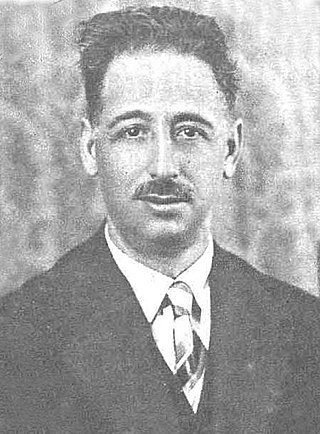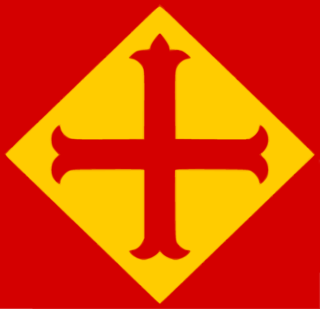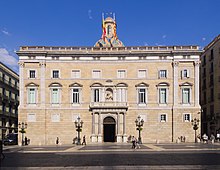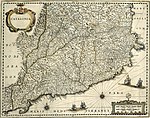
Lluís Companys i Jover was a Spanish politician from Catalonia who served as president of Catalonia from 1934 and during the Spanish Civil War.

The Popular Front in Spain's Second Republic was an electoral alliance and pact signed in January 1936 by various left-wing political organizations, instigated by Manuel Azaña for the purpose of contesting that year's election. In Catalonia and today's Valencian Community the name of the coalition was Front d'Esquerres.
The Republican Left of Catalonia is a pro-Catalan independence, social-democratic political party in the Spanish autonomous community of Catalonia, with a presence also in Valencia, the Balearic Islands and the French department of Pyrénées-Orientales. It is also the main sponsor of the independence movement from France and Spain in the territories known as Catalan Countries, focusing in recent years on the creation of a Catalan Republic in Catalonia proper. Its current president is Oriol Junqueras and its secretary-general is Marta Rovira. The party is a member of the European Free Alliance.

The Confederación Española de Derechas Autónomas, was a Spanish political party in the Second Spanish Republic. A Catholic conservative force, it was the political heir to Ángel Herrera Oria's Acción Popular and defined itself in terms of the 'affirmation and defence of the principles of Christian civilization,' translating this theoretical stand into a practical demand for the revision of the republican constitution. The CEDA saw itself as a defensive organisation, formed to protect religion, family, and property. José María Gil-Robles declared his intention to "give Spain a true unity, a new spirit, a totalitarian polity..." and went on to say "Democracy is not an end but a mean to achieve the conquest of the new state. When the time comes, either parliament submits or we will eliminate it." The CEDA held fascist-style rallies, called Gil-Robles "Jefe", the equivalent of Duce, and claimed that the CEDA might lead a "March on Madrid" to forcefully seize power.

The Spanish Republic, commonly known as the Second Spanish Republic, was the form of government in Spain from 1931 to 1939. The Republic was proclaimed on 14 April 1931, after the deposition of King Alfonso XIII, and was dissolved on 1 April 1939 after surrendering in the Spanish Civil War to the Nationalists led by General Francisco Franco.

Legislative elections were held in Spain on 16 February 1936. At stake were all 473 seats in the unicameral Cortes Generales. The winners of the 1936 elections were the Popular Front, a left-wing coalition of the Spanish Socialist Workers' Party (PSOE), Republican Left (Spain) (IR), Esquerra Republicana de Catalunya (ERC), Republican Union (UR), Communist Party of Spain (PCE), Acció Catalana (AC), and other parties. Their coalition commanded a narrow lead over the divided opposition in terms of the popular vote, but a significant lead over the main opposition party, Spanish Confederation of the Autonomous Right (CEDA), in terms of seats. The election had been prompted by a collapse of a government led by Alejandro Lerroux, and his Radical Republican Party. Manuel Azaña would replace Manuel Portela Valladares, caretaker, as prime minister.

Elections to Spain's legislature, the Cortes Generales, were held on 19 November 1933 for all 473 seats in the unicameral Cortes of the Second Spanish Republic. Since the previous elections of 1931, a new constitution had been ratified, and the franchise extended to more than six million women. The governing Republican-Socialist coalition had fallen apart, with the Radical Republican Party beginning to support a newly united political right.
The background of the Spanish Civil War dates back to the end of the 19th century, when the owners of large estates, called latifundios, held most of the power in a land-based oligarchy. The landowners' power was unsuccessfully challenged by the industrial and merchant sectors. In 1868 popular uprisings led to the overthrow of Queen Isabella II of the House of Bourbon. In 1873 Isabella's replacement, King Amadeo I of the House of Savoy, abdicated due to increasing political pressure, and the short-lived First Spanish Republic was proclaimed. After the restoration of the Bourbons in December 1874, Carlists and anarchists emerged in opposition to the monarchy. Alejandro Lerroux helped bring republicanism to the fore in Catalonia, where poverty was particularly acute. Growing resentment of conscription and of the military culminated in the Tragic Week in Barcelona in 1909. After the First World War, the working class, the industrial class, and the military united in hopes of removing the corrupt central government, but were unsuccessful. Fears of communism grew. A military coup brought Miguel Primo de Rivera to power in 1923, and he ran Spain as a military dictatorship. Support for his regime gradually faded, and he resigned in January 1930. There was little support for the monarchy in the major cities, and King Alfonso XIII abdicated; the Second Spanish Republic was formed, whose power would remain until the culmination of the Spanish Civil War. Monarchists would continue to oppose the Republic.

The Revolution of 1934, also known as the Revolution of October 1934 or the Revolutionary General Strike of 1934, was a revolutionary strike movement that took place between 5 and 19 October 1934, during the black biennium of the Second Spanish Republic. The revolts were triggered by the entry of the conservative Spanish Confederation of the Autonomous Right (CEDA) into the Spanish government. Most of the events occurred in Catalonia and Asturias and were supported by many Spanish Socialist Workers' Party (PSOE) and General Union of Workers (UGT) members, notably Largo Caballero, as well as members of the Confederación Nacional del Trabajo (CNT). Historians have argued that the incident sharpened antagonism between the political Right and Left in Spain and was part of the reason for the later Spanish Civil War. Around 2,000 people were killed during the uprising, which was repressed by Spanish government forces.

Domènec Batet i Mestres was a Spanish military man who became general of the Spanish Army.

The Statute of Autonomy of Catalonia of 1932, also called the Statute of Núria, was the first implemented statute of autonomy for Catalonia, officially providing self-government to Catalonia for the first time in more than 200 years. The Statute was promoted by the then acting President of the Generalitat, Francesc Macià and approved in a referendum by 99% of Catalan voters. The draft Statute was completed on 20 June 1931 in Núria and finally approved in the Spanish Parliament on 9 September 1932. It was implemented until the occupation of Catalonia by the Nationalist Army during the last stages of the Spanish Civil War, in 1939.

The Catalan Republic was a state proclaimed in 1931 by Francesc Macià as the "Catalan Republic within the Iberian Federation", in the context of the proclamation of the Second Spanish Republic. It was proclaimed on 14 April 1931, and superseded three days later, on 17 April, by the Generalitat de Catalunya, the Catalan institution of self-government within the Spanish Republic.

The Catalan State was a short-lived state proclaimed during the events of 6 October 1934 by Lluís Companys as the "Catalan State within the Spanish Federal Republic".

Miquel Badia i Capell (1906–1936) was a prominent figure of radical Catalan separatism during the days of the Second Spanish Republic, member of Estat Català and the JEREC, Chief of Public Order of the Generalitat of Catalonia. He became known among his followers as Capità Collons.

Jaime Carner Romeu was a Spanish lawyer, businessman and politician from Catalonia. He was a deputy in the Cortes before World War I, then pursued a career as a corporate lawyer until the Second Spanish Republic when he was again elected deputy. He was Minister of Finance from 1931 to 1933.

When, in 1939, World War II erupted in Europe, Catalonia was part of Spain led by the caudillo Francisco Franco, who declared Spain neutral in the conflict. The country was devastated by the recently finished Spanish Civil War, which resulted in the defeat of the Second Spanish Republic and the creation of the Spanish State, and Catalonia, who was an autonomous region under the Republican government (1931-1939) lost the whole of its self-government when the Nationalist army occupied the area.
Events from 1934 in Catalonia.

The Catalan coup d'etat was an unsuccessful takeover of power in autonomous Catalonia, planned by the independentist party Estat Català. The conspirators intended to declare the total independence of Catalonia as a state neutral in the Spanish Civil War, and to marginalize all non-aligned political groupings, especially the Anarchists. They counted on party militias and Catalan army and security units, infiltrated by the Estat Català militants. The coup was planned in November, as the plotters assumed that the central Republican government, absorbed by the battle of Madrid, would not be able to take action. The plot failed because of the Anarchist counter-action, which exposed the scheme and some of its leaders. In pre-emptive strike Generalitat services detained a few of the conspirators; the others fled to France. Estat Català was sidelined, while CNT-FAI ensured its dominant position in Catalonia. The attempted coup remains a poorly researched and rather unknown episode; in historiography it is discussed against the background of Catalan fascism.
Enric Pérez i Farràs was a Catalan military commander.

Josep Dencàs i Puigdollers was a Catalan nationalist politician active in the Republican Left of Catalonia.


















